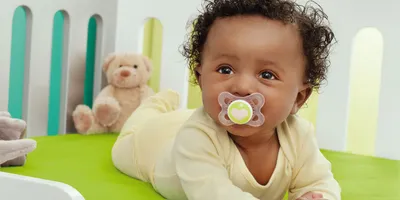Crazy, but true: Your baby bump will get even bigger over the coming weeks! The main task of your little one is to put on even more baby fat. Find out why it's not bad news if your baby is still not in the head-down position, what you need to pack for your stay in hospital, and other interesting facts now that you are 31 weeks pregnant.
What's Going On in Your Belly at 31 Weeks Pregnant?
The fetus is around 16 inches long (crown to heel) and weighs roughly 3.5 lbs.
There is very little space to spare in the womb now. If your baby is in a breech position (in other words "sitting" on its bottom), it has until around week 35 of your pregnancy to turn upside down.
Your baby is now roughly the weight of a butternut squash.

- Cephalic presentation (also referred to as vertex or head-first presentation): The fetus lies head down in the pelvis
- Breech presentation (Br.): The fetus sits upright on its bottom in the pelvis
- Oblique lie: The fetus lies diagonally in the womb
- Transverse lie: The fetus lies horizontally in the womb
You can encourage the baby to turn by performing certain exercises. Ask your doctor if you wish to know more, but avoid attempting to turn the baby on your own. Otherwise complications may arise depending on the course of your pregnancy or any pre-existing conditions that exist. After all, there is no rush when it comes to your little one turning – it may do a somersault at any time over the course of the coming month.
The baby is now growing fast: Around ½ an inch per week. Maybe that’s why it’s so tired? The baby currently sleeps for around 20 hours per day.
All of its senses have now fully developed.
How Do You Feel at 31 Weeks Pregnant?
Are you still walking normally, or have you started to waddle? It may be hard to imagine, but your baby bump is nowhere near its full size yet! This affects your body's center of gravity, your posture, and how you walk. The big bump and your body's preparation for the birth also bring a few symptoms with them. Aside from actual aches and pains, day-to-day life becomes generally more difficult for expectant mothers. Putting socks on, going shopping, and working all become a bit more strenuous.
Typical pregnancy symptoms in week 31 of pregnancy (or the third trimester):
- Braxton Hicks (practice contractions)
- Back pain
- Heartburn
- Pelvic pain
- Headaches
- Dizziness or circulatory problems
- Difficulty sleeping
- Dry nails
- "Leaky" breasts (colostrum)
- Frequent urge to urinate
- Shortness of breath
Simple remedies can help to ease many of these problems: Rest and drink plenty of water. However, taking it easy may not be so simple if young siblings are already around. An ideal time to get your partner more involved! Of course, devoted grandparents, uncles, aunties, and other babysitters can also be helpful at this time. After all, your body is putting in a lot of work at the moment – any assistance is welcome!
You can start to think about packing your hospital bag now. Which raises the question:
What do you really need in your hospital bag?
- You should always carry important documents with you: For example, your antenatal care record and any other documents relating to your pregnancy, as well as your most important medical information (such as height, weight, blood type, allergies, pre-existing conditions) and your ID.
- Non-perishable snacks such as glucose tablets, trail mix, or dried fruits and nuts, as well as muesli bars, can also be popped in your bag. They will replenish your energy between contractions or during waiting times in the hospital.
- A long, comfy T-shirt or nightshirt to wear during labor (if you do not wish to wear a hospital gown)
- A nightshirt or pajamas that button up: Comfortable, clean, front-opening clothes for wearing after the birth that are ideal for breastfeeding
- Maternity bra: It is advisable to choose a cheap bra initially, since your breast size could still change. You may also wish to wear maternity bras during your pregnancy.
- Comfortable clothing for the journey home: Your belly will be smaller, but it will not have disappeared entirely. Pants with an elastic waistband or dresses are therefore very practical. You should select items of clothing that are as comfortable as possible, not too tight, and easy to put on, because you may require a cesarean section or sustain injuries from childbirth.
- Full-size panties: Thick pads are often used to contain your post-birth vaginal discharge, which may be heavy at the beginning – more generous briefs are therefore practical. Bear in mind that you may also have a cesarean section: Your underwear should not be cut too low in the pubic area to avoid the elastic irritating the scar. Briefs cut higher to the waist are advisable.
- Your most important hygiene and care products: Toothbrush, toothpaste, hairbrush/comb, moisturizer
- Slippers
- You may wish to pack a bathrobe and cozy socks
- Cell phone charger
- 1-2 sets of baby clothes, e.g., sleepsuit, pants, vest, and a baby hat
- Perhaps a pacifier for a newborn and a baby bottle: When selecting the pacifier, make sure it is very lightweight and designed with an orthodontic nipple. When choosing the bottle, you should also always make sure the nipple is small and suitable for newborn babies to prevent your little one from choking.
Happy packing!
Pregnancy Week 30
Nutrition in the Third Trimester
Pregnancy Week 32
Building Up Energy Reserves Until Your Milk Comes In

The third trimester: Welcoming a new life
with MAM-expert Dr. Tony (Tao) Duan




















